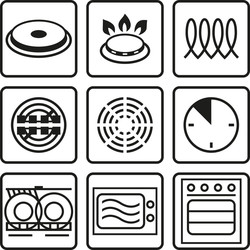General
Before a food product is consumed, it comes into contact with a variety of objects made of a wide range of materials during production, storage, processing and preparation: tableware, kitchen utensils, packaging, but also various equipment used for preparation. Food contact materials used include plastics, ceramics, metals, wood and many more.
Food contact materials must not release substances in quantities that are harmful to health. Furthermore, the food must not be contaminated by the release of undesirable substances (contaminants). This also includes an odor or taste impairment of the food. The labeling and presentation of the articles must not be misleading.
Further information on contaminants can be foundhere.
Material groups
Plastics
Many food contact items today are made of plastics. These include bottles (often made of PET), storage cans, cling film, kitchen utensils and many more.
Plastic-like materials
Not everything that looks like plastic is. Plastic-like materials include epoxy resins, paints and coatings used as surface coatings on items that come in contact with food. Cellophane films are also used as food packaging materials. Elastomers, or rubber or rubber-like materials such as silicone, are used for bottle teats and soothers but also for gaskets, hoses and in baking pans.
Ceramics and enamel
Because of their composition and high firing or processing temperature, objects made of ceramics, enamel and glass are mainly subject to contamination by metals.
Active and intelligent materials
Active materials and articles are designed to extend the shelf life of a packaged food product or to maintain or improve its condition. Smart materials and items are capable of monitoring the condition of a packaged food or the environment surrounding the food.
Glass, metals and alloys
Metals and alloys are widely used in food contact: from cutlery, to pots and pans, to cans or aluminum foil, a variety of metallic objects come into contact with food.
Situation in Austria
Food contact materials are routinely analysed as part of official food controls. In 2022, 52 (15.2%) of the 342 samples analysed were rejected. 31 samples (9.1%) were objected to primarily due to missing or inadequate declarations of compliance. 14 samples (4.1 %) were assessed as misleading due to their presentation. Two samples (0.6%) were found to be harmful to health due to excessive levels of primary aromatic amines (PAA). PAA describes a group of chemical compounds that are used, for example, in the production of certain colourants. Some of these substances are carcinogenic.
In addition, regular focus campaigns are also carried out:
- Inorganic materials and articles for food contact
- Food contact materials made of polystyrene and copolymers of styrene
- Harmful substances in uncoated paper and cardboard with direct food contact
- Metallicity of decorated souvenir, handicraft or manufactured ceramic goods
- Primary aromatic amines in kitchen utensils made of polyamide (nylon)
- Primary aromatic amines in nylon kitchenware
- Analysis of ceramic, glass and crystal crockery
- Document control of empty, fillable packaging materials made of plastic and coated cardboard and testing for specific migration of metals
- Metal leakage from uncoated pots, pans and other metal crockery
- Aluminium trays from communal catering and other food fillers including gastronomy
- Suitability of party accessories for food contact
- Plastic identification and document control for packaging made of/with plastic
- Utility articles for food contact made of melamine-formaldehyde resin

Tips
- Pay attention to manufacturers' warnings and instructions for use (e.g. not suitable for the dishwasher or microwave oven, limited temperature or acid resistance, cleaning instructions) and save any labels that may be present.
- Do not purchase food contact products that have a strong odor.
- Before first use, clean products thoroughly with water and household detergent or according to available instructions.
- Do not use kitchen utensils that are very worn or cannot be cleaned. This also applies to tableware.
- Be careful with materials and items sold as antiques: these do not have to meet today's food safety requirements.
- A food suitability symbol (glass and fork) present on an item guarantees that it is intended and suitable for food contact. However, this does not automatically cover all conceivable applications. For example, packaging such as PET bottles or aluminum cans are intended for single use only. Products should therefore only be used as intended and the emptied packaging should be disposed of in the waste collection systems provided for this purpose. However, items that are clearly intended to come into contact with food (e.g. drinking glasses, cooking pots, etc.) or that are already in contact with food (such as packaged food) are not required to display this symbol.
Information for manufacturers and distributors
Legal requirements for food contact materials in Austria are regulated in the Food Safety and Consumer Protection Act(LMSVG). In addition, the EU regulationsVO (EC) 1935/2004 andVO (EC) No. 2023/2006 apply. For individual material groups, there are also specific EU-wide regulations.
Manufacturers and distributors must inform themselves whether the materials and articles they use are subject to individual measures according to Art. 5 of Regulation (EC) 1935/2004. If this is the case, manufacturers and distributors may be obliged as a company to issue a declaration of conformity confirming that the materials or articles comply with the applicable regulations. The details of the required contents can be found in the corresponding individual measures (e.g. for plastics in Annex IV ofRegulation (EC) No. 10/2011).
If the material or article is not additionally regulated by an individual measure, the conformity does not have to be certified by a declaration of compliance, but the requirements of Regulation (EC) No. 1935/2004 still apply to all food contact materials. In addition, according to Regulation (EC) No. 2023/2006, appropriate documentation for the conformity and safety of the finished material or article must be prepared and maintained. This documentation must be made available to the competent authorities upon their request.
Legal basis
Plastics
In the EU, food contact materials made of plastics are regulated by Regulation (EC) No. 10/2011. Only substances listed in the Union list of this regulation may be used as starting materials. This list contains monomers and other starting materials, as well as additives and auxiliary substances for better processability. For articles made of plastic, a declaration of conformity issued by the company confirming compliance with the legal requirements is required within the supply chain.
Regulation (EU) 2022/1616 applies to recycled plastic.
Regulation (EC) No. 284/2011 applies to imports of polyamide and melamine plastic kitchenware originating from China or Hong Kong, with specific conditions and detailed procedures.
Plastic-like materials
Not everything that looks like plastic is also covered by Regulation (EC) No. 10/2011. There are separate regulations for the following materials:
Epoxy resins: Regulation (EC) No. 1895/2005 on the restriction of the use of certain epoxy derivatives in materials and articles intended to come into contact with food.
Paints and coatings: Regulation (EU) 2018/213 on the use of bisphenol A in paints and coatings intended to come into contact with food and amending Regulation (EU) No. 10/2011 as regards the use of this substance in plastic food contact materials.
regenerated cellulose film: Federal Law Gazette No. 128/1994 on articles made of regenerated cellulose film (Regulation on regenerated cellulose film)
Elastomers/rubber (in the case of bottle teats and soothers): Federal Law Gazette No. 104/1995 on the release of N-nitrosamines and N-nitrosatable substances from bottle teats and soothers made of elastomers or rubber
Ceramics and enamel
In the EU, Directive 84/500/EEC applies to ceramic articles, which was implemented nationally in Austria as the Ceramics Ordinance (BGBl. No. 893/1993). This regulation also regulates enamel. In contrast to the EU Directive, it sets limits not only for lead and cadmium, but also for antimony, barium and zinc. A declaration of conformity issued by the entrepreneur is required for these items within the supply chain up to retail.
Active and intelligent materials
Regulation (EC) No. 450/2009 applies to them.
Materials not specifically regulated
For all materials not explicitly listed, there are currently no specific regulations at EU level. However, they must comply with Regulation (EC) No. 1935/2004 and Regulation (EC) No. 2023/2006. These materials include, for example, paper, cardboard, glass, wood, metals, coatings, adhesives, silicones and printing inks.
A declaration of conformity issued by the company is not mandatory for these materials, but conformity must still be demonstrated with appropriate documentation. In these cases, Council of Europe recommendations, recommendations of the Federal Institute for Risk Assessment (BfR), standards or even scientific publications are to be consulted for conformity verification.
Glass
As there is no individual measure for glass according to Art. 5 of Regulation (EC) No. 1935/2004, the same requirements for the release of lead and cadmium as for ceramics in the Ceramics Regulation(BGBl. No. 893/1993) can be used for the assessment due to the similar composition and processing conditions.
Metals and alloys
Since there is no individual measure for metals and alloys according to Art. 5 of Regulation (EC) No. 1935/2004, other documents must be used for their assessment. For this purpose, the requirements of the Council of Europe Guideline "Metals and alloys used in food contact materials and articles" are used, which contains test methods and scientific assessments of the most important metals.
Paper and cardboard
As there is no individual measure for paper and board according to Art. 5 of Regulation (EC) No. 1935/2004, other documents have to be used for their evaluation. For this purpose, the requirements of the Council of Europe Guideline "Paper and Board used in food contact materials and articles" are used, which contains test methods and scientific criteria for compliance assessment.
Further information
Austrian Food Codex, Codex chapter B36 commodities
Brochure of the European Commission on food contact materials
Last updated: 26.08.2024
automatically translated

